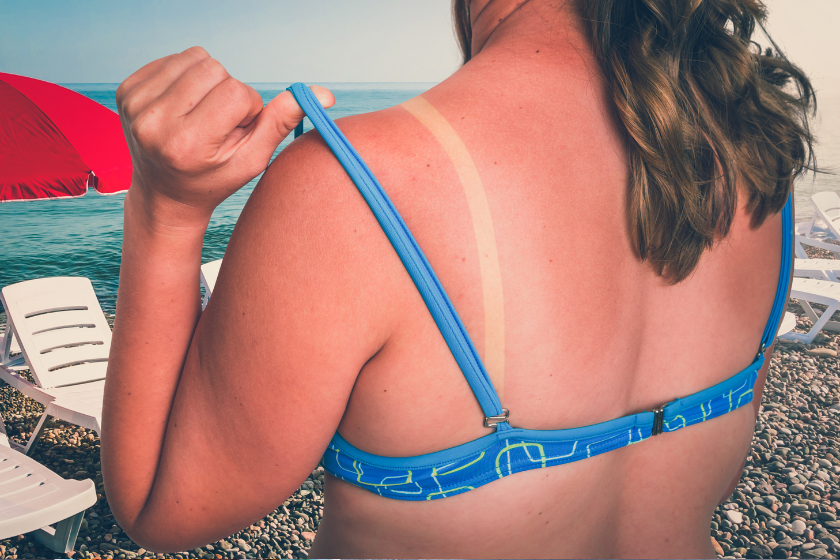How to prevent your kids—and yourself—from getting sunburned

As the weather warms up and outdoor activities become more frequent, it’s essential to remember the importance of protecting children’s skin from the sun.
It’s more than just a temporary discomfort—sunburns can have long-lasting effects on health. Having five or more sunburns can double the risk of developing melanoma, and just one blistering sunburn in childhood or adolescence more than doubles the chance of developing melanoma.1 (A blistering sunburn is a more severe form of sunburn characterized by blisters on the skin.)
What is melanoma?
While not the most common type of 皮肤癌, melanoma is the most serious skin cancer and is responsible for the majority of skin cancer deaths. Sunburns during childhood significantly increase your risk of melanoma.
Melanoma is usually caused by exposure to ultraviolet (UV) rays from the sun and tanning beds. Genetic and environmental factors can also play a role, so by the time your kids are old enough to be going to the doctor on their own, you’ll want to make sure they are aware of any relevant family history so they can communicate that with their health care providers.
How can I help my child prevent sunburns?
Kids can be harmed by the sun—burn or no burn. But so much important (and healthy!) childhood fun happens outside. Here’s what you can do to support the health of their skin so they can play safely:
Use sunscreen effectively: Apply a broad-spectrum sunscreen with an SPF of at least 30. Make sure to cover all exposed skin, and reapply every two hours, or more often if swimming or sweating.
We get it—applying sunscreen on kids can be a challenge, but there are some products and tips to make it a bit easier. For babies under six months old, the Food and Drug Administration and American Academy of Pediatrics recommend against sunscreen because of their extra sensitive skin, so you’ll want to keep them covered or in the shade.
Is putting on sunscreen a fight in your house? The more you make a habit of it, the more your kids will just expect it (kind of like brushing their teeth!). They may even remind you to apply your sunscreen when you forget!
另请阅读 | 确保孩子在海滩安全健康的 5 种意想不到的方法
Seek shade: Encourage your kids (of all ages) to play in shaded areas, especially when sunlight is the strongest between 10 a.m. and 4 p.m. Use umbrellas, tents or trees to provide shade where you can.
Wear protective clothing: Dress your kids in lightweight, long-sleeved shirts, pants and wide-brimmed hats. UPF (Ultraviolet Protection Factor) clothing protects your skin from the sun by blocking UVA and UVB rays with its fabric. Sunglasses with UV protection are also important to protect their eyes. If you’re swimming or at the beach, long-sleeve rash guards can provide protection while keeping kids cool.
另请阅读 | How melanoma led me to reinvent sun protection
Avoid tanning and sunbathing: Tanning is never safe—teach your kids that indoor tanning and sunbathing are harmful practices. Both excessive time in the sun and any of use of tanning beds expose your skin to harmful UV radiation, which can significantly increase your risk of skin cancer. The goal is to protect their skin, not to get a tan.
Be cautious on cloudy days: UV rays can penetrate clouds, so it’s important to use sun protection even when the weather is overcast.
Stay hydrated: Despite what you may have heard, there is no scientific evidence that drinking water can prevent sunburns. However, it’s still important to stay hydrated. Ensure your children are drinking plenty of water—and if you’re sunburned, drinking extra water will help prevent dehydration.
Educating kids about the importance of sun protection is key. Make it a fun and engaging topic by getting them involved: Let them choose their sun hats or apply sunscreen together. The more they understand the reasons behind these precautions, the more likely they are to adopt these habits for life.
另请阅读 | 阵亡将士纪念日周末防晒要带什么
Help! I’ve had some pretty serious sunburns. What should I do to protect myself now?
It’s ok—sometimes, sunburns happen. The good news is sun safety is an ongoing practice, and there are many habits you can adopt to make sure you’re staying safe, preventing future burns, and staying ahead of cancer.
- Learn the ABCDEs of skin cancer: 这 ABCDE rule is to help check for suspicious moles. If you notice any of the following, report it to your health care provider immediately.
- Asymmetry: One half of the mole doesn’t match the other
- Border: The mole is uneven in shape with jagged, notched, or blurred edges
- Color: The mole is not uniform in color
- Diameter: The mole has a diameter greater than 6mm (about the size of a pencil eraser)
- Evolution: There’s any change in the size, shape, color or elevation or the mole, or you experience any new symptoms (such as bleeding, itching or crusting)
- Get an annual skin cancer check: Visit a dermatologist or your health care provider once a year to have your skin examined by a professional.
- Adopt sun safe habits: Make sure to put on sunscreen after applying it on your kids—your health matters, too! The same goes for covering up with a hat, sunglasses and protective clothing.
- Soothe your skin: If you get a sunburn, use aloe vera gel to soothe your skin and apply cool, damp cloths to reduce heat and discomfort.
Preventing sunburns in childhood is a critical step in reducing the risk of melanoma. By taking simple yet effective measures, you can protect your family’s skin and support their long-term health. Remember, the habits we instill now, no matter the age, will make a difference in the future.
1皮肤癌基金会